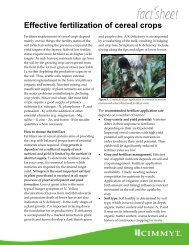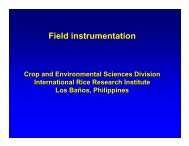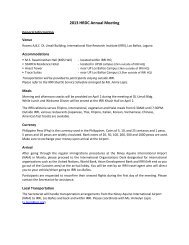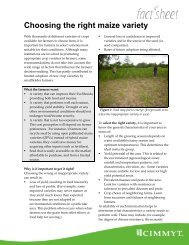Water management in irrigated rice - Rice Knowledge Bank ...
Water management in irrigated rice - Rice Knowledge Bank ...
Water management in irrigated rice - Rice Knowledge Bank ...
- No tags were found...
Create successful ePaper yourself
Turn your PDF publications into a flip-book with our unique Google optimized e-Paper software.
Table 3.4. <strong>Water</strong> <strong>in</strong>put (I = irrigation R = ra<strong>in</strong>fall) and yield of two aerobic <strong>rice</strong> varieties (HD502, HD297) under flooded andaerobic conditions <strong>in</strong> 2001 and 2002, Beij<strong>in</strong>g, Ch<strong>in</strong>a. Data from Yang Xiaoguang et al (2005).Year<strong>Water</strong> <strong>Water</strong> <strong>in</strong>put (mm) Yield (t ha −1 )<strong>management</strong>I I + R HD502 HD2972001 Flooded 1,057 1,351 6.8 5.4aerobic 350 644 5.3 4.7283 577 4.6 4.3292 586 4.3 4.2225 519 3.5 3.4175 469 3.0 2.52002 Flooded 900 1,255 4.6 5.3aerobic 522 917 5.7 5.3374 769 4.8 4.7225 620 4.0 3.9300 695 4.3 4.6152 547 3.6 2.9upland crop, such as wheat or maize. Unlike lowland<strong>rice</strong>, upland crops are grown <strong>in</strong> nonpuddled,nonsaturated (i.e., “aerobic”) soil without pondedwater. When ra<strong>in</strong>fall is <strong>in</strong>sufficient, irrigation is appliedto br<strong>in</strong>g the soil water content <strong>in</strong> the root zoneup to field capacity after it has reached a certa<strong>in</strong>lower threshold level, such as halfway between fieldcapacity and wilt<strong>in</strong>g po<strong>in</strong>t (Doorenbos and Pruit1984). The amount of irrigation water should matchevaporation from the soil and transpiration by thecrop (plus any application <strong>in</strong>efficiency losses). Thepotential water reductions at the field level when<strong>rice</strong> can be grown as an upland crop are large, especiallyon soils with high seepage and percolationrates (Bouman 2001; Chapter 3.5). Besides seepageand percolation losses decl<strong>in</strong><strong>in</strong>g, evaporation decreasess<strong>in</strong>ce there is no ponded water layer, and thelarge amount of water used for wet land preparationis elim<strong>in</strong>ated altogether (Chapter 3.1.3).In Asia, “upland <strong>rice</strong>” is already grown aerobicallywith m<strong>in</strong>imal <strong>in</strong>puts <strong>in</strong> the upland environment,but mostly as a low-yield<strong>in</strong>g subsistence cropto give stable yields under the adverse environmentalconditions of the uplands (Lafitte et al 2002).Upland <strong>rice</strong> varieties are drought tolerant, but havea low yield potential and tend to lodge under highlevels of external <strong>in</strong>puts such as fertilizer and supplementalirrigation. Alternatively, high-yield<strong>in</strong>glowland <strong>rice</strong> varieties grown under aerobic soilconditions, but with supplemental irrigation, havebeen shown to save water, but at a severe yieldpenalty (Blackwell et al 1985, Westcott and V<strong>in</strong>es1986, McCauley 1990). Achiev<strong>in</strong>g high yieldsunder <strong>irrigated</strong> but aerobic soil conditions requiresnew varieties of “aerobic <strong>rice</strong>” that comb<strong>in</strong>e thedrought-tolerant characteristics of upland varietieswith the high-yield<strong>in</strong>g characteristics of lowlandvarieties (Lafitte et al 2002, Atl<strong>in</strong> et al 2006).The development of temperate aerobic <strong>rice</strong>started <strong>in</strong> the mid-eighties <strong>in</strong> northern Ch<strong>in</strong>a andBrazil. In Ch<strong>in</strong>a, breeders have produced aerobic<strong>rice</strong> varieties with an estimated yield potential of6-7 t ha –1 (Wang Huaqi et al 2002). In experimentswith Ch<strong>in</strong>ese aerobic <strong>rice</strong> varieties close to Beij<strong>in</strong>g<strong>in</strong> 2001 and 2002, Yang Xiaoguang et al (2005) andBouman et al (2006b) obta<strong>in</strong>ed aerobic <strong>rice</strong> yieldsof 2.5−5.7 t ha −1 with only 500−900 mm of total(irrigation plus ra<strong>in</strong>fall) water <strong>in</strong>put (Table 3.4). Forcomparison, the aerobic varieties yielded 5.4−6.8t ha −1 under flooded lowland conditions, receiv<strong>in</strong>gabout 1,300 mm of total water <strong>in</strong>put. At the samesite, Xue et al (2007) reported yield maxima of3.6−4.5 t ha −1 with 688 mm of total water <strong>in</strong>put <strong>in</strong>2003, and 6.0 t ha −1 with 705 mm of water <strong>in</strong>put<strong>in</strong> 2004 (Table 3.5). The relatively high yields ofaerobic <strong>rice</strong> at Beij<strong>in</strong>g were obta<strong>in</strong>ed under “harsh”conditions for grow<strong>in</strong>g <strong>rice</strong>. The soil conta<strong>in</strong>edmore than 80% sand, was permeable, and heldwater above field capacity for a few hours afterirrigation only. The groundwater table was deeperthan 20 m, the soil moisture content <strong>in</strong> the root zonewas mostly between 50% and 80% of saturation,and soil moisture tensions went up to 90 kPa (seeFig. 2.3 <strong>in</strong> Chapter 2.1). In field experiments near24





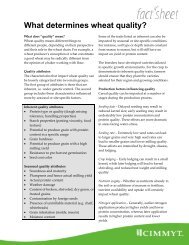

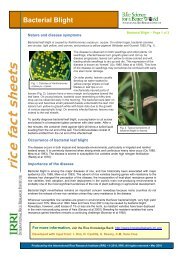

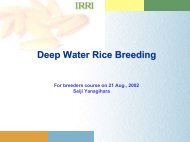
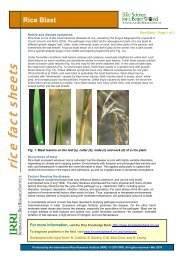
![International Standards' Organization â Rice Specification [ISO 7301]](https://img.yumpu.com/36696862/1/190x245/international-standards-organization-a-rice-specification-iso-7301.jpg?quality=85)

